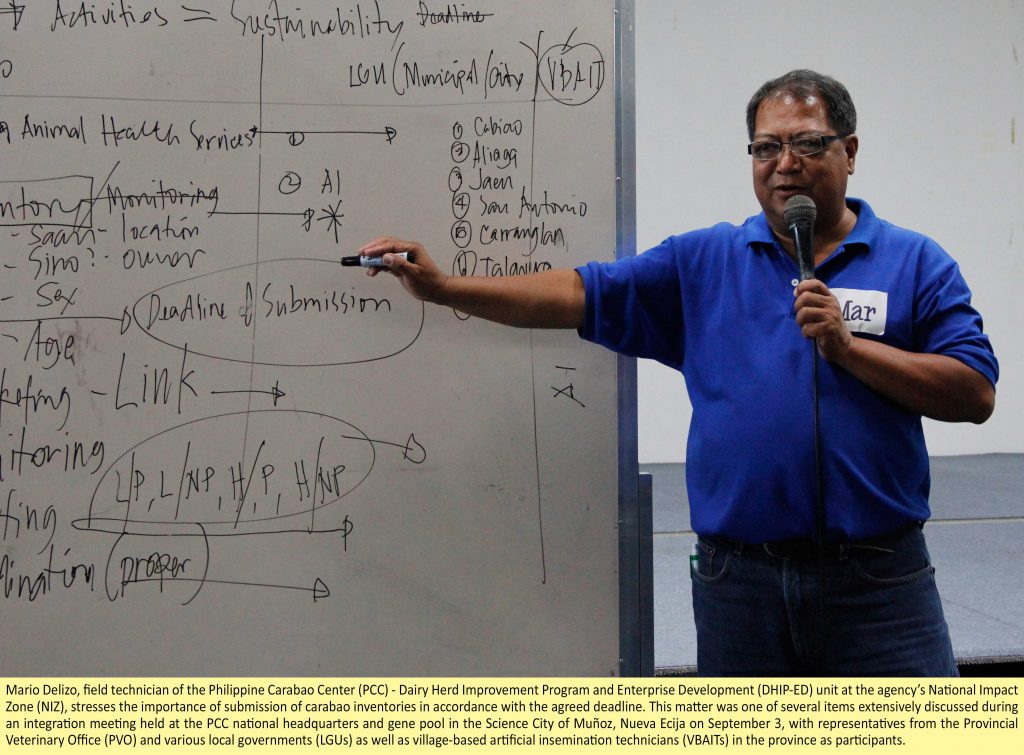Starting October, various local government units (LGUs) in Nueva Ecija, in coordination with the provincial veterinary office (PVO), are expected to gather, consolidate and submit reports regarding the total herd inventory of native, crossbred and purebred carabaos in their respective towns to the Philippine Carabao Center (PCC).
This was the main outcome of an integration meeting attended by representatives from various LGUs, the PVO and village-based artificial insemination technicians (VBAITs) last September 3 at the PCC national headquarters and gene pool in the Science City of Muñoz, N.E.
Titled “Carabao-based Enterprise Development (CBED) program for target 2 million liters of milk in Nueva Ecija by 2016 integration meeting”, the activity was organized by the Dairy Herd Improvement Program and Enterprise Development unit at the National Impact Zone (DHIP-ED at NIZ) and CBED unit of the PCC.
The meeting was held as part of the agency’s overall efforts to further strengthen its partnership with LGUs and the PVO aimed at achieving its goal of two million liters of milk harvest by 2016.
Matters discussed during the meeting included PCC’s CBED program, breeding and artificial insemination in Nueva Ecija, agency services and current challenges that need to be met in light of the targeted milk harvest by 2016.
Estella P. Valiente, community development officer I, explained PCC’s CBED. She emphasized that the program aims to give farmers additional income from carabao’s meat, milk and hide, provide the communities with better nutrition and improve the general well-being of the rural farm families through the conservation, propagation and promotion of the carabao.
On the other hand, Dr. Fe Venturina, AI coordinator based at PCC-Central Luzon State University (PCC-CLSU), discussed matters related to the breeding program, which involves continuous backcrossing.
“In Nueva Ecija alone, technicians PCC at CLSU, along with the VBAITs, inseminate 5,000 carabaos every year,” she revealed.
“Data show that our calf drop is about 30%. To be able to reach our goal, we need to provide 8,000 AI services and have 2,400 lactating animals on the ground annually,” she emphasized.
“Therefore, carabao inventories are important so that we know where to find carabaos that need to be inseminated, aside from our established data on the purebred and some crossbreds as well as native animals,” she added.
Mario Delizo, field technician of PCC’s DHIP-ED at NIZ, presented and discussed PCC services and the challenges that need to be met in order to achieve the target of two million liters of milk harvest by 2016 in Nueva Ecija.
He pointed out that PCC’s services include project monitoring, linkaging with public and private sectors, marketing, milk collection, training, provision of planting materials for forage, breeding services (AI and bull loan) and other related technical services.
The challenges that PCC is currently facing mainly involve provision of animal health services (vaccination and deworming in particular), emergency treatment for buffaloes due to PCC’s limited staff in DHIP-ED at NIZ, report generation from dairy cooperatives, and up-to-date inventory of all breedable native and crossbred carabaos.
Various LGU’s and the PVO committed to assist the PCC in providing animal health services to the farmers’ carabaos and continuously updating and submitting carabao inventories. They also vowed to help the PCC in monitoring and reporting various data and information needed by the agency.
Dr. Felomino V. Mamuad, PCC deputy executive director; and Dr. Peregrino Duran, head of PCC’s DHIP-ED at NIZ gave messages during the opening and closing rites, respectively, of the event.
Mamuad pointed out the importance of carabao inventories and the need to solve the issue on genetically improved carabaos that are being sold outside the province.
“We should know how we can avoid the scenario wherein our farmers sell their genetically superior animals to other provinces. We want our province to maintain the best of the best of our stocks and that we’re the first one to produce the Philippine Murrah Buffalo in the future. I hope that this meeting will strengthen our partnership to attain that purpose and we’ll also able to gather all the inventories of our carabaos in N.E. for us to achieve our two million milk harvest target by 2016,” he declared
Duran, on the other hand, thanked all the participants who attended the meeting. He emphasized the importance of the vital role of all concerned entities in meeting the two million liters of milk target. He also expressed the hope that the collaborative efforts would help sustain the development of the dairy industry in Nueva Ecija.

